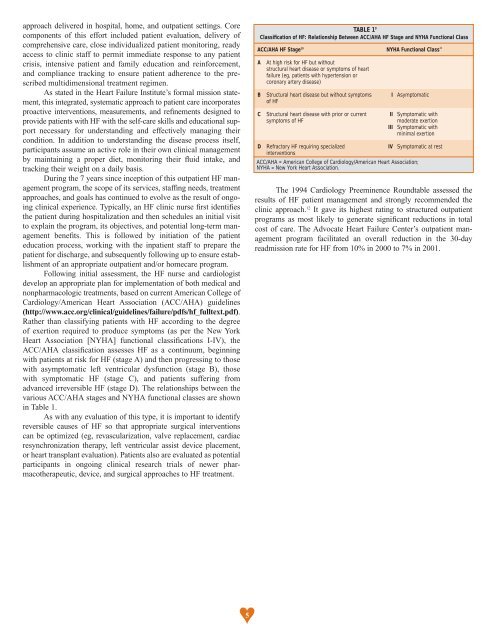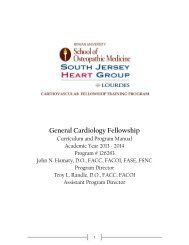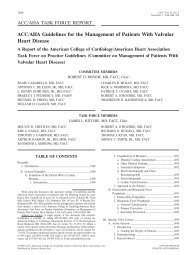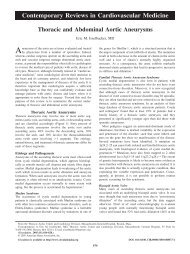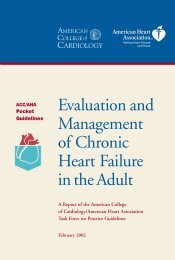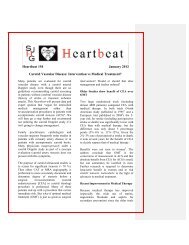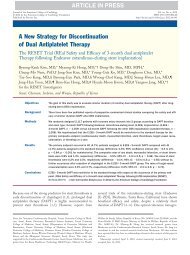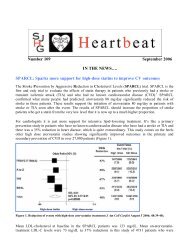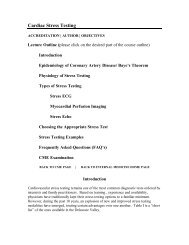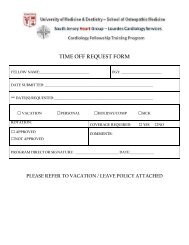Outpatient Management of Heart Failure
Outpatient Management of Heart Failure
Outpatient Management of Heart Failure
Create successful ePaper yourself
Turn your PDF publications into a flip-book with our unique Google optimized e-Paper software.
approach delivered in hospital, home, and outpatient settings. Core<br />
components <strong>of</strong> this effort included patient evaluation, delivery <strong>of</strong><br />
comprehensive care, close individualized patient monitoring, ready<br />
access to clinic staff to permit immediate response to any patient<br />
crisis, intensive patient and family education and reinforcement,<br />
and compliance tracking to ensure patient adherence to the prescribed<br />
multidimensional treatment regimen.<br />
As stated in the <strong>Heart</strong> <strong>Failure</strong> Institute’s formal mission statement,<br />
this integrated, systematic approach to patient care incorporates<br />
proactive interventions, measurements, and refinements designed to<br />
provide patients with HF with the self-care skills and educational support<br />
necessary for understanding and effectively managing their<br />
condition. In addition to understanding the disease process itself,<br />
participants assume an active role in their own clinical management<br />
by maintaining a proper diet, monitoring their fluid intake, and<br />
tracking their weight on a daily basis.<br />
During the 7 years since inception <strong>of</strong> this outpatient HF management<br />
program, the scope <strong>of</strong> its services, staffing needs, treatment<br />
approaches, and goals has continued to evolve as the result <strong>of</strong> ongoing<br />
clinical experience. Typically, an HF clinic nurse first identifies<br />
the patient during hospitalization and then schedules an initial visit<br />
to explain the program, its objectives, and potential long-term management<br />
benefits. This is followed by initiation <strong>of</strong> the patient<br />
education process, working with the inpatient staff to prepare the<br />
patient for discharge, and subsequently following up to ensure establishment<br />
<strong>of</strong> an appropriate outpatient and/or homecare program.<br />
Following initial assessment, the HF nurse and cardiologist<br />
develop an appropriate plan for implementation <strong>of</strong> both medical and<br />
nonpharmacologic treatments, based on current American College <strong>of</strong><br />
Cardiology/American <strong>Heart</strong> Association (ACC/AHA) guidelines<br />
(http://www.acc.org/clinical/guidelines/failure/pdfs/hf_fulltext.pdf).<br />
Rather than classifying patients with HF according to the degree<br />
<strong>of</strong> exertion required to produce symptoms (as per the New York<br />
<strong>Heart</strong> Association [NYHA] functional classifications I-IV), the<br />
ACC/AHA classification assesses HF as a continuum, beginning<br />
with patients at risk for HF (stage A) and then progressing to those<br />
with asymptomatic left ventricular dysfunction (stage B), those<br />
with symptomatic HF (stage C), and patients suffering from<br />
advanced irreversible HF (stage D). The relationships between the<br />
various ACC/AHA stages and NYHA functional classes are shown<br />
in Table 1.<br />
As with any evaluation <strong>of</strong> this type, it is important to identify<br />
reversible causes <strong>of</strong> HF so that appropriate surgical interventions<br />
can be optimized (eg, revascularization, valve replacement, cardiac<br />
resynchronization therapy, left ventricular assist device placement,<br />
or heart transplant evaluation). Patients also are evaluated as potential<br />
participants in ongoing clinical research trials <strong>of</strong> newer pharmacotherapeutic,<br />
device, and surgical approaches to HF treatment.<br />
♥ 5<br />
TABLE 1 9<br />
Classification <strong>of</strong> HF: Relationship Between ACC/AHA HF Stage and NYHA Functional Class<br />
ACC/AHA HF Stage 10 NYHA Functional Class 11<br />
A At high risk for HF but without<br />
structural heart disease or symptoms <strong>of</strong> heart<br />
failure (eg, patients with hypertension or<br />
coronary artery disease)<br />
B Structural heart disease but without symptoms I Asymptomatic<br />
<strong>of</strong> HF<br />
C Structural heart disease with prior or current II Symptomatic with<br />
symptoms <strong>of</strong> HF moderate exertion<br />
III Symptomatic with<br />
minimal exertion<br />
D Refractory HF requiring specialized<br />
interventions<br />
IV Symptomatic at rest<br />
ACC/AHA = American College <strong>of</strong> Cardiology/American <strong>Heart</strong> Association;<br />
NYHA = New York <strong>Heart</strong> Association.<br />
The 1994 Cardiology Preeminence Roundtable assessed the<br />
results <strong>of</strong> HF patient management and strongly recommended the<br />
clinic approach. 12 It gave its highest rating to structured outpatient<br />
programs as most likely to generate significant reductions in total<br />
cost <strong>of</strong> care. The Advocate <strong>Heart</strong> <strong>Failure</strong> Center’s outpatient management<br />
program facilitated an overall reduction in the 30-day<br />
readmission rate for HF from 10% in 2000 to 7% in 2001.


